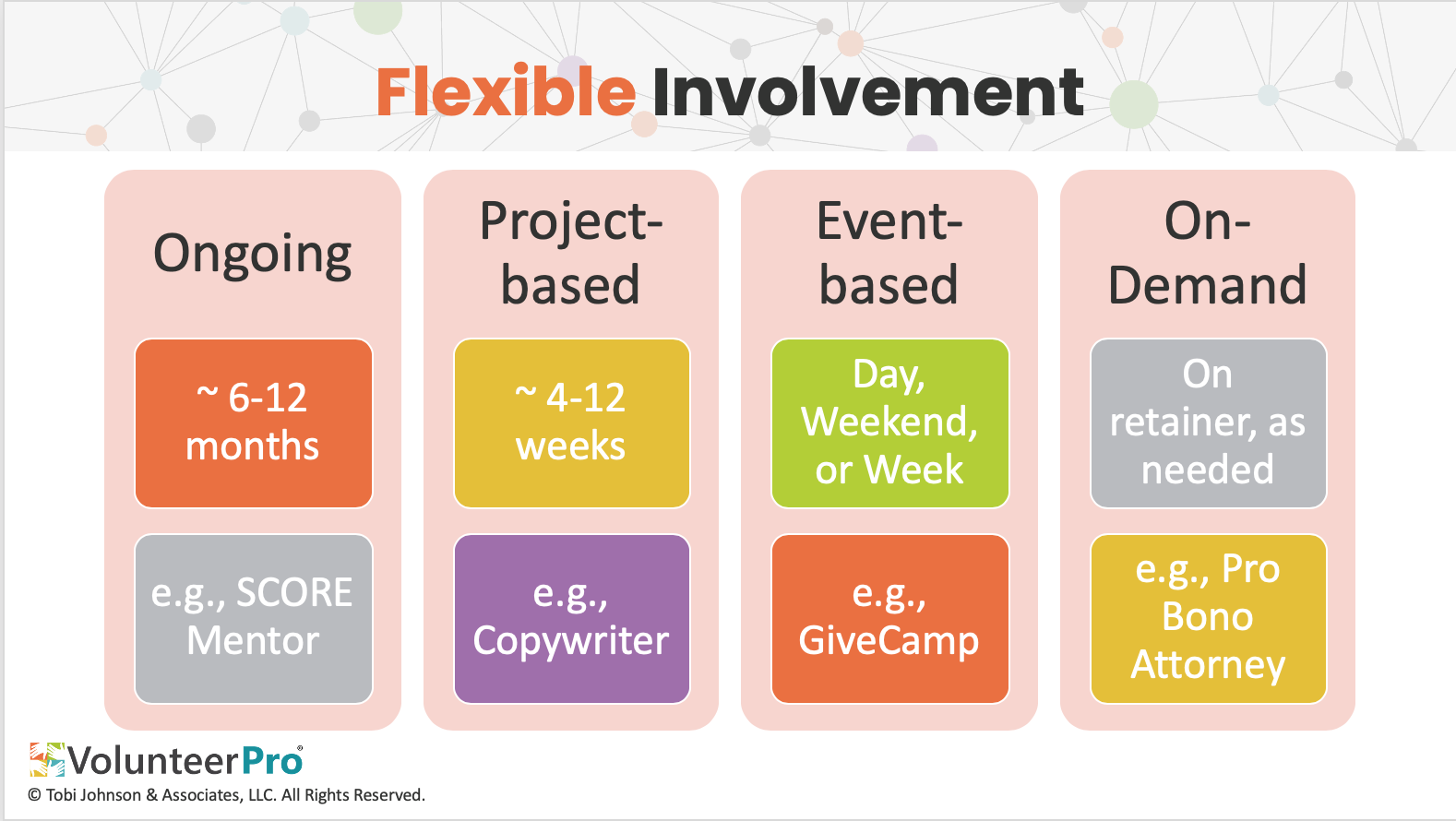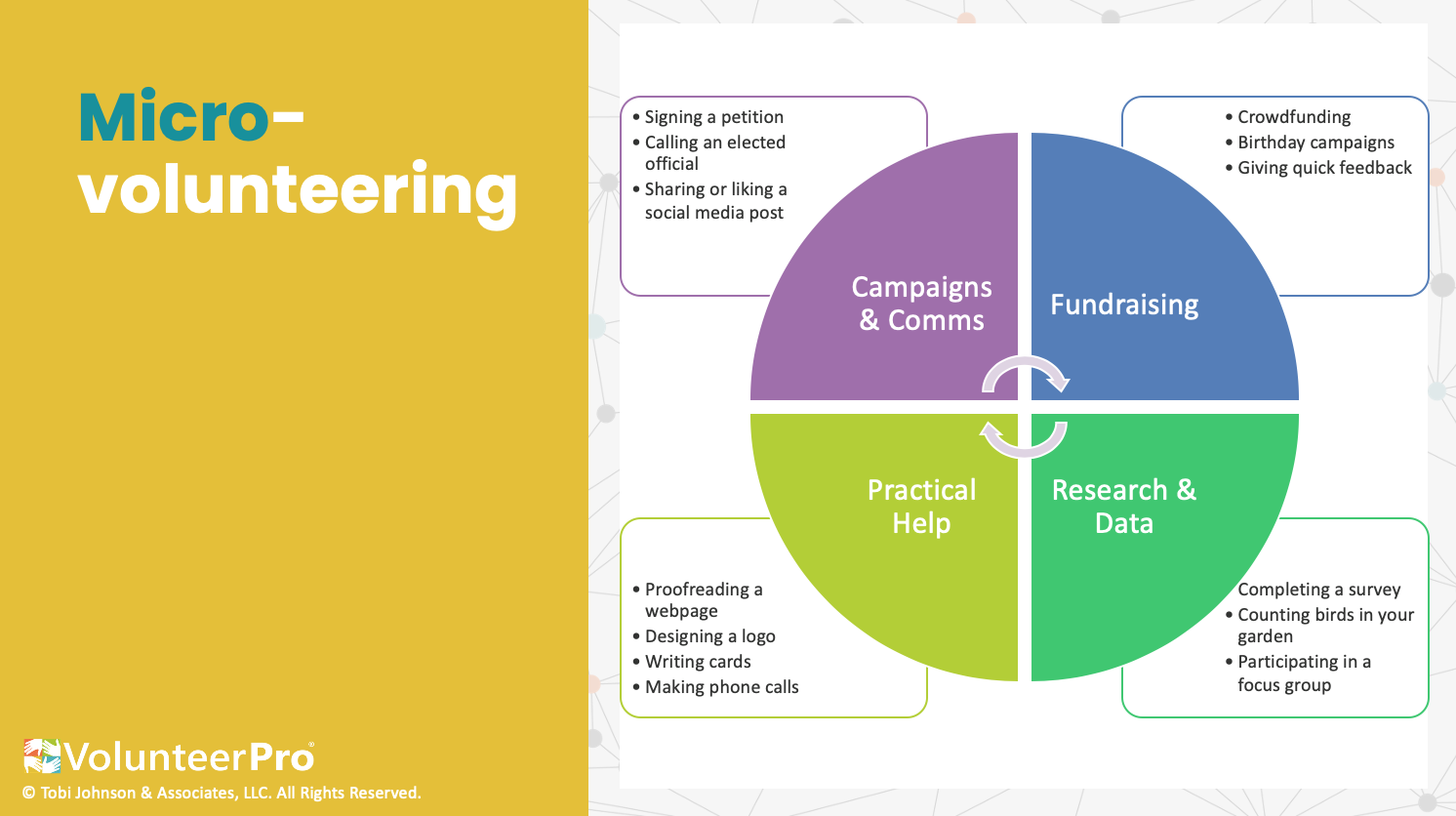 How to Engage Online Volunteers During COVID-19
How to Engage Online Volunteers During COVID-19
The current COVID-19 pandemic has wreaked havoc on traditional volunteering and many organizations are pivoting to embrace online volunteers.
While virtual volunteering isn’t new (the ubiquitous Wikipedia has been built entirely by e-volunteers since 2001), launching an online volunteering strategy in the midst of a global crisis is a novel experience for most.
In addition, many volunteer organizations have lacked the tools and digital maturity needed to pull off effective remote collaboration.
So, now volunteer resource managers around the world are spending long nights grappling with how to make it work.
They are wondering – How can I pull off a National Volunteer Week celebration without our annual recognition lunch? (hint: check out Valerie’s blog post on this topic). How can I keep folks in the loop without overwhelming them with information? How can I get my “low-tech” volunteers to ever embrace a digital experience? And more.
If virtual volunteering is new to your organization, it can feel overwhelming in the least.
When we take volunteering online, the assumption is that an entirely different set of rules apply, that our approach must pivot so much as to be indecipherable than what we did before.
But I’d like to suggest another take.
How about we go back to the fundamentals of volunteer resources management and work from there?
Online Volunteering: Start with the Fundamentals
Below are some of the key questions you need to answer when building a plan for involving volunteers online.
Note that it is the same foundation of any volunteer talent management planning process. Your fundamentals will continue to serve you well through this crisis.
So, consider the following six questions through the lens of virtual volunteering. The only things that need change or the sites where work is performed and, depending on the role, set schedules may not be required. Remote volunteers can simply contribute time when it fits into their schedules.
In addition, given the current crisis organizations need to be sensitive to the fact that people are stressed and overwhelmed and take purposeful steps to provide extra support.
One way to be more supportive is to offer a variety of flexible roles and time frames for volunteers to be involved. By doing this, you indicate to your supporters that you understand and empathize with their needs.
While this may feel like a new approach, offering a variety of roles has always been a best practice for volunteer organizations. And, in fact, volunteers in many of these roles, across the spectrum, can remain active, even now.
Consider how these roles could be converted to an online option:
- TRADITIONAL VOLUNTEERING
Many traditional volunteer roles can be converted to a virtual version. Consider SCORE. For over 50 years, SCORE has helped small businesses get off the ground, grow and achieve their goals through education and mentorship. They are supported by the U.S. Small Business Administration (SBA) and has a network of 11,000+ volunteers. SCORE has already made the move to remote mentoring, from their traditional model, with little major disruption to services.
- PROJECT AND SKILLS-BASED VOLUNTEERING
Catchafire helps match nonprofits in need with technical experts for a wide range of online projects, including how to transition to online work (very meta!). They have experienced a surge in website visitors over the past few months as organizations realize the opportunities inherent in this moment. VolunteerMatch also has a special hub for virtual opportunities directly related to COVID-19.
- EVENT-BASED VOLUNTEERING
For over a decade, GiveCamp has channeled the raw energy the developer community towards helping charities during “Charity Challenge Weekends” where several charities and digital marketers come together to rebuild communications platforms. While working in the same room is a lot of fun, this approach could also be approached completely online, with one team working with one charity.
- ON-DEMAND VOLUNTEERING
Now, more than ever, volunteers are also needed on an ad-hoc basis. Pro-bono legal assistance, safety experts, human resources consultants, etc. can be helpful resources when organizations grapple with best practices and need quick answers around employees and volunteer engagement during times of upheaval and crisis. The American Bar Association, as well as local legal societies and others, can help organizations find help.
- MICRO-VOLUNTEERING
Micro-volunteering is also a fantastic option to keep online volunteers engaged, but not overwhelm them. At this time, people may be more likely to volunteer their time in short and convenient, bite-sized chunks. Micro-volunteering offers volunteers a series of easy tasks that can be done anytime, from their own homes, on their own terms. The concept isn’t new. It has historically been done mostly in the UK. Check out the UK-based Help from Home website for ideas and opportunities and download their exceptional free guide.
Below are a few examples across four areas:
With a little imagination, even direct service volunteering traditionally undertaken in person can be in full or in part, transferred online.
- Friendly visitor or support volunteer can write notes, make phone calls, and record collaborative video greetings rather than visiting in person.
- Mentors can meet with mentees online using a video conferencing platform. Need to supervise youth and adult mentoring pairs? Use Zoom rooms to set up virtual breakout rooms with either a supervisor sitting in each. Or, set them up to automatically record and spot check the recordings after the fact.
- Some volunteer opportunities (e.g., trail maintenance volunteers) may still be able to perform their work on their own, provided they follow local guidelines and take care to protect their health. However, they may need to check-in and communicate online rather than stopping by the office.
And the list goes on. Consider which roles you already engage and see if there are ways to convert them into virtual opportunities.
Also, to engage volunteers in online projects, consider any of the following:
- Brainstorming a creative solution to a nagging problem via a group Zoom video call
- Getting volunteers involved in developing, deploying, and presenting the results of a survey of clients or volunteers
- Collecting volunteer stories of change and transformation
- Training volunteers up to become ambassadors for your organization
- Forming an Agency Recovery Team whose job is to develop a proactive plan for re-entry after COVID-19
Finally, review your emerging needs and go back to fundamental questions — How Many Volunteers? Supporting Which Departments (or Sites)? In Which Roles? On What Days/Times? For What Duration? With What Talents?
Then, consider the tools and training they will need to get started and you’re well on your way to success.
Online Volunteering: Unique Considerations
I’ve learned a lot from working as a digital entrepreneur for the past five years. While we may think that technology has special powers, the reality is that it is both a help and a hindrance.
Things will break, folks will be challenged, meetings won’t be as efficient as you’d like them to be. So, it’s important to give your team (and yourself) some time to learn how everything works. It is not easy at first, but it gets easier later.
The other thing to recognize is that supporting remote volunteers takes a slightly different approach, or at the very least a more intense focus on support.
Researchers have found that successfully leading a remote workforce does take a deeper understanding of this unique context.
In particular, leaders need to work actively against the phenomenon of virtual distance, defined as the perceived or psychological distance that grows when we rely heavily on virtual communication.
Interesting is the fact that it can be found in co-located and far-flung teams. In other words, virtual distance can impact volunteers and employees working in the same building but separated by organizational silos.
According to researcher and writer Karen Lojeski, when virtual distance is relatively high:
- Innovative behaviors fall by over 93%
- Trust declines by over 80%
- Cooperative and helping behaviors go down by over 80%
- Role and goal clarity decline by 75%
- Project success drops by over 50%
- Organizational commitment and satisfaction decline by more than 50%
While this research ash focused on employee engagement, imagine what this might mean for volunteer involvement and teamwork.
Virtual Distance is comprised of …
- Physical Distance – Location issues related to space & time
- Operational Distance – Psychological gaps that grow due to issues that arise in the workplace
- Affinity Distance – The emotional disconnects between team members due to lack of relationship formation & development; the most important to address
Affinity Distance is, by far, the most important to address. In other words, as always, it’s the relationships that matter more than anything.
There’s no doubt that digital communications present major roadblocks to forming deep relationships necessary to learn and work effectively together.
Different types of distance hinder connection, but specific steps can be taken to reduce virtual distance. Fostering relationships is the most powerful way to reduce distance and can be achieved in a variety of ways.
Consider a combination of the following:
- Start every online meeting with chit-chat about the local context and environment (e.g., local weather, time zone, etc.)
- Encourage healthy use of the chat and polling features during webinars
- Send regular email updates (but don’t rely on this as your only tool)
- Set up phone trees to distribute the load for individual check-ins across a team
- Present regular teach-ins via Facebook Lives on your Facebook page
- Ask staff to record short volunteer recognition videos and schedule them out over Volunteer Appreciation Week
- Develop toolkits that can help volunteers be productive online
Also, trust can be eroded when working online. So, consider taking proactive steps to boost trust and confidence in the following three areas:
- General – Trust in one another, “exchange relationships”
-
- Use photos and video chat
-
- Offer low-risk actions (participate in a poll, rate content, suggest resources) as a gateway to higher-risk activities
-
- Communicate gratitude early and often
- Institution-based – the integrity of the organization, safety from negative consequences
-
- Make expectations and procedures transparent through clear and widely accessible communications
-
- Demonstrate trust in individual employees and volunteers
-
- Communicate that knowledge sharing is a norm and a moral obligation
- Knowledge-based – knowledge of members in the group
-
- Communicate norms and standards for sharing knowledge
-
- Model open, honest dialog amongst team members
-
- Establish that trust and knowledge sharing are mutually reinforcing
If you take extra steps to build trust, you’ll also see increased engagement when volunteers log on.
As you can see, there are several ways to involve volunteers online right now, but it doesn’t need to stop here.
Consider continuing the use of remote volunteer teams when your normal operations resume.
This practice can help you both remain resilient, but also offer an increasing diversity of roles to volunteers whose work or life obligations get in the way of engaging with you in person.









